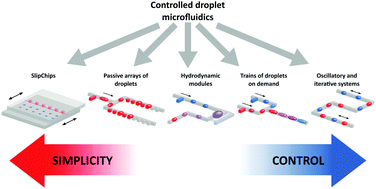Controlled droplet microfluidic systems for multistep chemical and biological assays
Abstract
Droplet microfluidics is a relatively new and rapidly evolving field of science focused on studying the hydrodynamics and properties of biphasic flows at the microscale, and on the development of systems for practical applications in chemistry, biology and materials science. Microdroplets present several unique characteristics of interest to a broader research community. The main distinguishing features include (i) large numbers of isolated compartments of tiny volumes that are ideal for single cell or single molecule assays, (ii) rapid mixing and negligible thermal inertia that all provide excellent control over reaction conditions, and (iii) the presence of two immiscible liquids and the interface between them that enables new or exotic processes (the synthesis of new functional materials and structures that are otherwise difficult to obtain, studies of the functions and properties of lipid and polymer membranes and execution of reactions at liquid–liquid interfaces). The most frequent application of droplet microfluidics relies on the generation of large numbers of compartments either for ultrahigh throughput screens or for the synthesis of functional materials composed of millions of droplets or particles. Droplet microfluidics has already evolved into a complex field. In this review we focus on ‘controlled droplet microfluidics’ – a portfolio of techniques that provide convenient platforms for multistep complex reaction protocols and that take advantage of automated and passive methods of fluid handling on a chip. ‘Controlled droplet microfluidics’ can be regarded as a group of methods capable of addressing and manipulating droplets in series. The functionality and complexity of controlled droplet microfluidic systems can be positioned between digital microfluidics (DMF) addressing each droplet individually using 2D arrays of electrodes and ultrahigh throughput droplet microfluidics focused on the generation of hundreds of thousands or even millions of picoliter droplets that cannot be individually addressed by their location on a chip.



 Please wait while we load your content...
Please wait while we load your content...